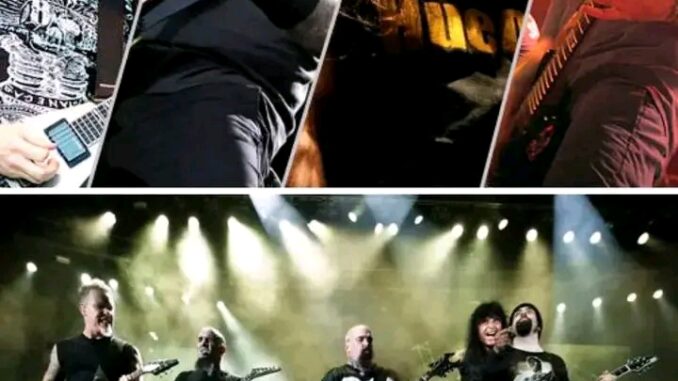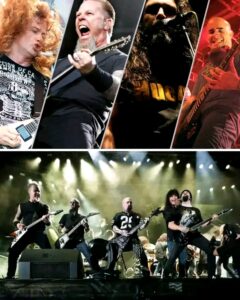
“Sofia 2010: The Night Metallica Took the Throne — How One Song, ‘Am I Evil?’, Shattered the Balance of Power..
𝐓𝐡𝐞 𝐍𝐢𝐠𝐡𝐭 𝐌𝐞𝐭𝐚𝐥𝐥𝐢𝐜𝐚 𝐃𝐞𝐜𝐥𝐚𝐫𝐞𝐝 𝐖𝐀𝐑: 𝐓𝐡𝐞 “𝐀𝐦 𝐈 𝐄𝐯𝐢𝐥?” 𝐌𝐨𝐦𝐞𝐧𝐭 𝐓𝐡𝐚𝐭 𝐁𝐑𝐎𝐊𝐄 𝐓𝐡𝐞 𝐁𝐢𝐠 4
In the vast and thunderous world of heavy metal, there are moments that define eras, moments when the noise transcends sound and becomes history. One such moment exploded into existence on a summer night in Sofia, Bulgaria—June 22, 2010. It wasn’t just another stop on the “Big 4” tour; it was a reckoning. A gathering of the gods—Metallica, Megadeth, Slayer, and Anthrax—bands that had shaped thrash metal and built an empire of sound that still echoes through the veins of every metalhead alive. But that night, something seismic happened. A single performance redefined the hierarchy of power. That night belonged to Metallica, and the song that triggered the quake was their blistering rendition of “Am I Evil?”-
A Historic Gathering of Titans
The concept of the Big 4 was, in itself, monumental. For decades, fans had dreamed of seeing Metallica, Megadeth, Slayer, and Anthrax—four bands that forged the thrash metal movement in the 1980s—share the same stage. Rivalries, egos, and time had long made it seem impossible. But in 2010, the impossible became real. Bulgaria’s Sofia Stadium was chosen as one of the tour’s crown jewels, drawing 70,000 roaring fans and millions more watching live in cinemas worldwide.
It was billed as a celebration—a salute to the past, a uniting of forces. Yet beneath the camaraderie lay an unspoken tension. These weren’t just friends reuniting; these were warriors entering the same arena, each armed with riffs, legacy, and pride.
And when the dust settled, one band stood taller than the rest.

Metallica’s Commanding Presence
From the moment Metallica hit the stage, it was clear they were there not just to perform, but to conquer. James Hetfield’s presence was magnetic—a commander standing before his army. Lars Ulrich pounded his drums with a mix of fury and precision, Kirk Hammett’s solos sliced through the air like lightning, and Robert Trujillo’s bass growled like an earthquake beneath them.
The band tore through a setlist that felt like a declaration of dominance: “Creeping Death,” “For Whom the Bell Tolls,” “Master of Puppets,” “Fade to Black.” The energy was feral, the delivery surgical. Every note screamed control—a reminder of why Metallica had transcended the thrash scene to become one of the biggest bands on Earth.
But the real story—the legend—was yet to unfold.
—
“Am I Evil?” – The Catalyst
As the final notes of “Seek & Destroy” faded, Hetfield stepped up to the mic and uttered a few fateful words that would ripple through metal history:
“Alright, are you evil?”
The opening chords of Diamond Head’s “Am I Evil?” thundered across the stadium. The song—a staple of Metallica’s early days—was already iconic in their catalog, a cover that defined their roots. But what happened next elevated it to myth.
One by one, members of Megadeth, Slayer, and Anthrax walked onto the stage. Dave Mustaine, once Metallica’s original guitarist and later their fiercest rival, stood beside Hetfield for the first time in decades. Kerry King from Slayer, Scott Ian from Anthrax, and others joined in. It wasn’t just a jam—it was an exorcism of decades of competition, bitterness, and history.
For a brief, electrifying moment, the gods of thrash became one.
—
Unity… or Dominance?
To the casual eye, it was a beautiful symbol of unity. The biggest names in metal, united in song, giving fans a once-in-a-lifetime sight. But for those who understood the dynamics of the Big 4, it was clear that something deeper—and more brutal—was unfolding.
Metallica didn’t just unite the scene; they owned it.
As Hetfield and Mustaine traded lines, the contrast was glaring. Hetfield’s voice was commanding, his posture unshakable. Mustaine—though legendary—seemed subdued, as though the weight of history hung on his shoulders. The crowd’s reaction wasn’t balanced either. Every roar favored Metallica. Every chant echoed their name.
It was as if the performance was a visual confirmation of what many had long whispered: Metallica wasn’t just part of the Big 4—they were above it.
—
A Shift in Power
From that night onward, the narrative changed. The Big 4 would perform together again, but the Sofia concert became the definitive statement of hierarchy.
Anthrax were the pioneers, Slayer the uncompromising purists, Megadeth the technical masterminds—but Metallica were the kings.
Critics and fans alike hailed the Sofia show as the night Metallica proved, once and for all, why they stood at the top of the mountain. It wasn’t about ego—it was about execution. Their sound was tighter, their stagecraft more powerful, and their chemistry undeniable.
Even the live recording, later released as The Big 4: Live from Sofia, Bulgaria, immortalized the moment. On screen, the body language said it all. Metallica commanded the stage while the others seemed to orbit around them.
That wasn’t arrogance—it was inevitability.
—
“Am I Evil?” — A Song That Defined Generations
The song itself carries symbolic weight. Originally written by Diamond Head, it became Metallica’s battle cry in their early years. It was the anthem that linked the band’s raw beginnings with their global domination. By choosing it as the song to unite the Big 4, Metallica weren’t just performing—they were reminding the world of where it all began, and how far they’d come.
When the entire metal universe sang the chorus—“Am I evil? Yes, I am!”—it was no longer just a lyric. It was a declaration of power, legacy, and immortality.
—
Aftershocks Across the Metal World
The impact of that night reverberated far beyond Sofia. Fans called it the “metal summit,” the “night the earth shook.” It reignited interest in thrash’s golden era, introduced younger audiences to its legends, and solidified Metallica’s untouchable status.
Even the rivalries seemed to soften, at least temporarily. Mustaine would later reflect on the night with a mixture of pride and melancholy, acknowledging its historic significance while hinting at the unspoken tensions beneath the surface.
For the rest of the Big 4, it was validation—but for Metallica, it was coronation.
—
Legacy of the War Cry
Fifteen years later, that Sofia performance remains one of the most replayed and discussed live moments in metal history. It stands as both a unifying event and a dividing line—a celebration and a declaration of dominance.
Fans remember it not only for the collaboration but for the way it captured the raw essence of what metal truly is: passion, rivalry, respect, and power.
When those first ominous chords of “Am I Evil?” rang out, Metallica didn’t just play a song.
They declared war—not against their peers, but against doubt itself. They reminded the world that no matter how high others climbed, the throne of metal still bore one name.
Metallica.
—
Because on that night in Sofia, under the electric roar of 70,000 faithful, the question wasn’t “Am I Evil?”
It was:
“Is there anyone
else who can rule this kingdom?”
And the answer, echoing from the stage to the stars, was a resounding no.
Leave a Reply